Einführung in
Entwicklungsländerstudien
Wir sind miteinander verknüpft

Wir sind miteinander verknüpft
mailto: payer@hdm-stuttgart.de
Zitierweise / cite as:
Entwicklungsländerstudien / hrsg. von Margarete Payer. -- Teil V: Ausgewählte Problemfelder der Entwicklung. -- Kapitel 51: Tourismus / zusammengestellt von Alois Payer. -- Teil II. -- Fassung vom 2001-02-23. -- URL: http://www.payer.de/entwicklung/entw512.htm. -- [Stichwort].
Erstmals publiziert: 2000-09-04
Überarbeitungen: 2018-10-06 [grundlegend überarbeitet] ; 2001-02-23 [Update]
Anlass: Lehrveranstaltung "Einführung in Entwicklungsländerstudien". HBI Stuttgart, 1998/99
©opyright: Dieser Text steht der Allgemeinheit zur Verfügung. Eine Verwertung in Publikationen, die über übliche Zitate hinausgeht, bedarf der ausdrücklichen Genehmigung der Herausgeberin.
Dieser Text ist Bestandteil der Abteilung Entwicklungsländer von Tüpfli's Global Village Library.
Skript, das von den Teilnehmern am Wahlpflichtfach "Entwicklungsländerstudien" an der HBI Stuttgart erarbeitet wird.
Teil II. = der vorliegende Teil
Teil I. -- URL: http://www.payer.de/entwicklung/entw511.htm.
Teil III. -- URL: http://www.payer.de/entwicklung/entw513.htm
Teil IV. -- URL: http://www.payer.de/entwicklung/entw514.htm
"Für Kurzweil war [in den Hotels] bestens gesorgt, an den nötigen Einrichtungen und Räumlichkeiten fehlte es bestimmt nicht:
- dreisprachige Bibliothek,
- Lesesaal,
- Konversationssaal,
- Billardsaal,
- Fechtsaal,
- Rauchersalon,
- Damensalon,
- Musiksaal,
- Orchester mir täglich drei Konzerten,
- Marionettentheater für die Kinder,
- Grastennisplätze,
- Kroquet,
- Ballspiel,
- Gottesdienste für alle Religionen,
- Kaffeesäle,
- Casino,
- Trauben- und Molkenkuren,
- Bengalische Beleuchtung der Landschaft,
- etc."
[Beschreibung der schweizerischen Hotels im 19 Jahrhundert in:
Wyler, Theo <1943 - >: Als die Echos noch gepachtet wurden : aus den Anfängen des Tourismus in der Schweinz. -- Zürich : NZZ, ©2000. -- ISBN 3858238252. -- S. 69. ]
"» Lifestyle« ist »in«, und nicht nur zu Hause. Auch im Urlaub möchte man auf den gewohnten Komfort nicht verzichten, sondern eher noch etwas komfortabler wohnen und sich mit feinem Essen verwöhnen lassen.
|
|
|
| Abb.: Nilkreuzfahrtschiff "King of
Thebes" mit Kabine [Quelle: http://www.naggar.4mg.com/KingofThebes.html. -- Zugriff am 2000-07-27] |
|
»Ägypten-Nilkreuzfahrten« werden von Pauschalreiseunternehmen angeboten. Aber nicht auf alten Nilschiffen wird gereist, sondern in einem »bequem und freundlich ausgestatteten Schiff. Der bekannte Sheraton-Service begleitet Sie auch während ihrer Nilkreuzfahrt«. [Vgl.: http://www.naggar.4mg.com/products.html. -- Zugriff am 2001-02-23]
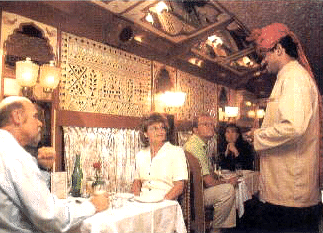
Abb.: Speisewagen des Palace on Wheels, Rajasthan, Indien
Und der Luxuszug »Palast auf Rädern« [Vgl.: http://www.dollarsavertravel.com/pages/specialty_pages/rail2g.html. -- Zugriff am 2001-02-23] startet mit zwei Restaurantwagen, Bar und Bibliothek von Delhi aus eine Rundreise durch den indischen Wüstenstaat Rajasthan. An jedem Bahnhof werden die Gäste mit Luxusautos empfangen, die sie zu den Sehenswürdigkeiten bringen. Gereist wird in »königlichen Waggons« der Maharadschas durch eine der ärmsten und wasserknappsten Gegenden Indiens.
|
|
|
Hotels der Spitzenklasse bieten auch in der Dritten Welt mehr als Swimming-pools: Das Hotel Elfenbein-Abidjan an der Elfenbeinküste lockt mit zwei Schwimmbädern, einem Eisstadion mit Curlingbahn, künstlichen Wasserkanälen mit Motorkanus und vielem anderem mehr (und ist der größte Stromverbraucher des Landes)."
[Hammelehle, Jürgen: Touristen- und Tourismus-Typen. -- In: Zum Beispiel Tourismus / Redaktion: Jürgen Hammelehle. -- 3., aktualisierte Aufl. -- Göttingen : Lamuv, ©1995. -- (Süd-Nord). -- ISBN 3889772129. -- S. 26. ]
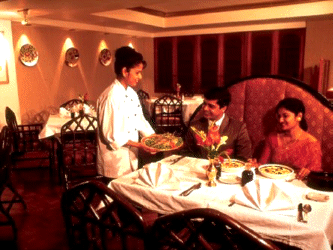
Abb.: Ciao - Italian Restaurant, The Pan Pacific Sonargaon Dhaka, Dhaka, Bangladesh, ein auf Geschäfts- und Incentive-Reisen spezialisiertes Hotel ("An oasis of luxury and tranquillity in the heart of bustling Dhaka city. The hotel provides extensive world class facilities and services to business travelers who expect comfort, efficiency and warm hospitality.") [Webpräsenz: http://www.panpac.com/bangladesh/dhaka/hotels/hotel.html. -- Zugriff am 2001-02-23]
[Bildquelle: http://www.panpac.com/bangladesh/dhaka/hotels/pictures_10.html. -- Zugriff am 2001-02-23]
"Für fleißige Außendienstmitarbeiter, als Belohnung für einen guten Geschäftsabschluss und bei anderen Gelegenheiten hat es sich für Firmen bewährt, Mitarbeiter auf Reisen zu schicken. Mehr Gehalt kann die Motivation heute kaum mehr steigern, eine sogenannte Incentive-Reise« wirkt aber oft Wunder. Sie erfreut sich auch bei Zielen in Ländern der Dritten Welt einer immer größeren Beliebtheit. Die verdienten Mitarbeiter oder Geschäftspartner werden auf der Reise wie VIPs (Very Important Person) behandelt."
[Hammelehle, Jürgen: Touristen- und Tourismus-Typen. -- In: Zum Beispiel Tourismus / Redaktion: Jürgen Hammelehle. -- 3., aktualisierte Aufl. -- Göttingen : Lamuv, ©1995. -- (Süd-Nord). -- ISBN 3889772129. -- S. 26 - 27. ]
Vgl.: IncentiveTravel.org.uk. -- URL: http://www.martex.co.uk/incentive-travel/. -- Zugriff am 2001-02-23
|
|
|
Verwandt mit Incentive-Reisen sind viele Formen des Sozialtourismus. Unter Sozialtourismus versteht man von Betrieben, Verbänden, kirchlichen Organisationen, dem Staat u.ä. subventionierte Urlaubs- und Erholungsreisen und -aufenthalte. In Deutschland gab es Sozialtourismus in großem Umfang im Dritten Reich ("Kraft durch Freude") sowie in der DDR ("Feriendienst des Freien Deutschen Gewerkschaftsbundes"). Obwohl dieser Sozialtourismus auch Auslandsreisen (Kreuzfahrten, Fahrten ins befreundete sozialistische Ausland) umfasste, war es doch vorwiegend ein Inlandstourismus. In Entwicklungsländern könnte Sozialtourismus bzw. tarifliches "Urlaubsgeld" den Binnentourismus ankurbeln.
"Ferien ohne Koffer? Kein Stress bei der Auswahl der Kleidung und beim Packen? Keine Schlepperei, kein Warten auf das Gepäck im Flughafen? Nur eine kleine Tasche über der Schulter? Ai MAXX macht's möglich. Ai steht hier nicht für amnesty international, sondern für die Zauberformel »All-inclusive«. MAXX ist ein Wortspiel mit Größenbezeichnungen. [Yahoo category: http://dir.yahoo.com/Business_and_Economy/Shopping_and_Services/Travel_and_Transportation/Lodging/Resorts/All_Inclusive/. -- Zugriff am 2001-02-23]
Wer beispielsweise in der Dominikanischen Republik den Urlaub nur mit Handgepäck bucht, erhält kostenlos rund 15 Kleidungsstücke, die miteinander kombinierbar sind. Badebekleidung, sechsmal Unterwäsche, Sandalen, Sonnenbrille, Sonnenschutzmittel, Sonnenhut/-kappe, Nassrasierer, Rasiercreme, After Shave, Zahnbürste, Zahnpasta, Haarbürste und Deodorant. Was nicht passt, wird vom hoteleigenen Schneider geändert. Der Wäscheservice ist inklusive. Wer möchte, kann die Urlaubskleidung in einer ebenfalls kostenlosen Reisetasche mit nach Hause nehmen.
Dieser durchaus ernstzunehmende Gag, der vorerst nur auf Erwachsene zugeschnitten ist, wurde 1998 auf der Internationalen Tourismus-Börse Berlin (ITB) vorgestellt. Er bedeutet sozusagen die (vorläufige) Krönung einer Urlaubsform, die sich seit Jahren steigender Beliebtheit erfreut. Kuba wartete mit einem anderen Höhepunkt auf. Der touristische Aufsteiger des vergangenen Jahres ließ gleich zwei Inseln sperren und zur All-inclusive-Zone erklären. Zutritt haben nur noch gebuchte Hotelgäste, die ohne Erkennungsmarke am Handgelenk überall und unbeschränkt essen, trinken, baden und Sport treiben dürfen. Auch deutsche Reiseveranstalter bieten inzwischen Hunderte von Ai-Anlagen an.
Vielen Verbrauchern erscheint »alles inklusive« als die optimale Reiseform, können doch sämtliche Kosten im Vorfeld ziemlich genau kalkuliert werden. Sind im Ai-Angebot neben der Vollpension tatsächlich sämtliche Getränke, Snacks rund um die Uhr, Sport- und Unterhaltungsmöglichkeiten enthalten, entfallen die meisten Nebenkosten. Und die sind in Urlaubszielen oft besonders hoch. Lediglich für die berühmten Postkarten an die Lieben daheim, für Souvenirs und Ausflüge, sofern man den Strand verlassen will, braucht man Bares oder die Kreditkarte. Besonders vorteilhaft lassen sich so die Ausgaben für Familien im Vorfeld planen. Insbesondere in der Karibik stehen viele Ai-Anlagen allerdings nur heterogenen Paaren oder Paaren und Singles ohne Kinder offen.
Den Titel »Erfinder des All-inclusive-Urlaubs« heften sich heute gleich mehrere Betreiber an die Brust. Doch so neu ist die Idee gar nicht. Zum einem gibt es seit Jahrzehnten preiswerte Ferienlager für Kinder und Jugendliche, insbesondere in Europa und in den USA, die einschließlich der - selbstverständlich nicht-alkoholischen Getränke - alles enthielten.
Der französische Club Med [Webpräsenz: http://www.clubmed.com/. -- Zugriff am 2001-02-23] begann 1951 ebenfalls mit Zelt- und Hüttendörfern, zählte jedoch auch Erwachsene zu seiner Klientel. Er warb als erster mit »touts compris«, alles inklusive. Im familienfreundlichen Reisepreis waren Mahlzeiten, Tischweine, Animateure, Sport und Unterhaltung enthalten. Es fehlten nur zusätzliche Getränke, die mit zuvor gekauften Glasperlen erstanden werden konnten.
Erste All-inclusive-Clubs mit großem Komfort und kostenlosem Alkoholausschank entstanden in den 70er Jahren für Paare auf Jamaika und St. Lucia in der Karibik. 1981 eröffnete auf Jamaika die Luxuskette Sandals [Webpräsenz: http://www.sandals.com/. -- Zugriff am 2001-02-23], die bis heute keine Kinder akzeptiert. 1993 entstanden in der Dominikanischen Republik die Allegro Resorts [Webpräsenz: http://www.allegroresorts.com/. -- Zugriff am 2001-02-23] aus dem Zusammenschluss zweier Hotelketten. Sie expandierten inzwischen bis nach Nordafrika und gelten heute als der größte Ai-Anbieter. In Europa etablierte sich 1990 der türkische Magiclife Club [Webpräsenz: http://www.magiclife.at/-- Zugriff am 2001-02-23], der Ai-Clubs in Österreich, Griechenland, Mexiko, in der Türkei und in der Dominikanischen Republik unterhält. Inzwischen werden zahlreiche weitere Ai-Anlagen gebaut sowie Ferienclubs und Hotels zu All-inclusive umfunktioniert. Nicht alle halten indes, was sie versprechen.
Ein All-inclusive-Urlaub lässt sich bereits in einer ganzen Reihe von Ländern verbringen. Noch immer führend ist die Karibik. Jeweils mehrere Dutzend Ai-Ressorts sind in der Dominikanischen Republik, auf Jamaika und Kuba zu finden. Weitere Ai-Strandhotels gibt es u.a. auf Antigua & Barbuda, Aruba, auf den Bahamas, auf Barbados, Grenada, St. Kitts, St. Lucia, Trinidad & Tobago sowie auf den Turks & Caicos Islands. Auf dem amerikanischen Kontinent lässt sich in Mexiko, Costa Rica und in Südamerika am Strand all-inclusive urlauben, in Afrika in Ägypten, Gambia, Marokko und Tunesien, ferner in der Türkei, auf Sri Lanka und in Thailand. Streng genommen fallen pauschale Trekkingreisen ebenfalls unter All-inclusive, beispielsweise im Himalaja-Königreich Nepal. Denn wer dort mehrere Wochen im Gebirge unterwegs ist, hat keinerlei Nebenkosten. Das mobile 3 bis 5-Sterne-Hotel wandert auf Träger- oder Yakrücken mit. In den meisten Dörfern gibt es nichts zu kaufen.
In Europa findet man All-inclusive-Hotels auf Mallorca, in Griechenland, Frankreich, Deutschland (auf Rügen, im Harz, in den Alpen) und in Österreich. In den Alpen kann man neuerdings auch all-inclusive skifahren. Dabei handelt es sich aber nicht immer um komplette Serviceangebote.
Überhaupt solle der interessierte Urlauber die Kataloge sehr sorgfältig studieren, vor allem das Kleingedruckte. »All-inclusive« ist kein geschützter Begriff, warnen Verbraucherschutzverbände, die auch im übersteigerten Anspruchsdenken »Ich will alles« eine Gefahr wittern. Kühle Köpfe entdecken Widersprüche dagegen rechtzeitig, z.B. wenn ein Veranstalter ein Hotel als »all-inclusive« anbietet, aber auf der nächsten Seite die Getränke mittags und abends auf ein »Glas Tischwein oder Bier« beschränkt. Generell müssen die Offerten für alkoholische Getränke und Sportmöglichkeiten besonders kritisch unter die Lupe genommen werden. Hier klafft das Leistungsspektrum inzwischen weit auseinander. Selbst in den teuren Luxusanlagen sind aufwendige Sportarten und internationale Bargetränke nicht unbedingt inklusive. Anderswo muss für die Spezialitätenrestaurants extra bezahlt werden. Bei Billiganbietern können Essen, Sport und Unterhaltungsprogramm schnell eintönig werden, und dreist werde häufig beim Sport eingeschränkt, warnen Verbraucherschützer. Da kann Tennis beispielsweise nur während der heißen Mittagsstunden kostenlos gespielt werden und sind Wasserski oder Windsurfen nur zu den Zeiten gratis, wenn die Wellen zu hoch schlagen. Auch Liegen und Sonnenschirme bleiben ein Problem. Zwar bekomme jeder Gast eine Liege zugesichert, jedoch nicht am Strand und am Pool. Der Kampf um die reservierte Liege geht also weiter. Rechtlich gelte: Was im Katalog steht, muss angeboten werden. Bei Einschränkungen handele es sich um Mogelpackungen.
Auch Touristiker fordern daher übereinstimmend ehrliche, transparente und umfangreiche Angebote, damit »gute Produkte nicht unter den schlechten leiden.« Einige befürworten »grenzenlosen Komplettservice«, andere glauben, selbst »lupenreines, teures All-inclusive« könne Gäste durch »Vielfalt auch abschrecken«. Denn nicht jeder nutze alle Sport- und Unterhaltungsmöglichkeiten, obwohl er dafür bezahlt habe, und konsumiere Unmengen am Buffet oder in der Bar. Viele Urlauber befürchten anscheinend, für andere bezahlen zu müssen und halten zu Beginn kräftig mit. In der Regel, so die Ai-Betreiber, pendele sich aber der Konsum nach ein paar Tagen ein. Vielesser und -trinker würden in der Preiskalkulation durch Touristen, die wenig verzehrten, ausgeglichen. Überhaupt gehöre das Bild des dickbäuchigen Strandurlaubers, der schon morgens eine Alkoholfahne vor sich hertrage, zu den Ausnahmeerscheinungen. Generell verschiebe sich der Standard eher von dreisternigen Mittelklasseanlagen zu gehobenen Viersterne-Häusern und hochpreisigen Luxusressorts, meinen Beobachter der Ai-Szene. Sie glauben auch, dass in Zukunft eine Spezialisierung eintreten wird, vor allem im Bereich des Sports und der Verpflegung, und dass Ai-Angebote dem klassischen Cluburlaub durch verstärkte Animation immer ähnlicher werden.
Viele Fachleute sind sich einig, dass es auf Dauer besser sein dürfte, »Viel Inclusive« anstatt »Alles inclusive« oder gar »Ultra«, »Super-« und »Unlimited-All-inclusive« anzubieten. Denn die »eierlegende Wollmilchsau«, die alle zufrieden stellt, könne ein Ai-Angebot nicht sein oder werden. Da seien die Interessen und Bedürfnisse der internationalen Gäste und Betreiber zu unterschiedlich. Die einen wollen nur schlemmen, abschalten und Ruhe, andere Animation und Action. Insbesondere Deutsche reisen gerne mit Vollkasko-Mentalität und einem großen Sicherheitsbedürfnis an und verlangen das Totalangebot. Viele Gäste genießen es, sich um absolut nichts zu kümmern und die Anlage nicht verlassen zu müssen. Nicht wenige erfreut die »Philosophie der Gleichheit«, die einige Anbieter forcieren.
»Letztlich entscheidet immer der Konsument«, sagt ein Clubinhaber und betont: »Bei uns will der Gast die Freiheit, auch spät zu frühstücken, nachts einen Snack zu essen oder seine ersten Surfversuche zu wagen - mit oder ohne Kinder.«
Nur mit »Reisen« habe der Ferienaufenthalt in einer Ai-Anlage wenig zu tun, glauben Tourismuskritiker und entwicklungspolitische Organisationen. Auch wenn ein bedeutender Ai-Betreiber -- im Hinblick auf die eigenen Restaurants- - suggeriere, »Sie können rund um die ganze Welt reisen - von Japan bis nach Jamaika und zurück - ohne die Anlage jemals zu verlassen.« Man könne sogar »erforschen« und »entdecken«, nämlich weitere Ressorts derselben Kette. Zutreffender sei da schon die Werbung, man könne »die ganze Welt hinter sich lassen«. Genau hier scheiden sich die Geister.
Löste bereits der Club-Urlaub heftige Diskussionen wegen des Ghetto-Charakters aus, verstärkt sich beim All-inclusive-Konzept die Frage, wer von Ai-Ressorts profitiert und wer nicht. Skeptische Stimmen gegenüber der streng bewachten »Rundumversorgung hinterm Stacheldraht« wurden auch in der Reisebranche selbst laut, wenngleich sie nun nach den jüngsten Ai-Erfolgen leiser klingen. So wird befürchtet, dass Ai unter anderem dazu führen kann, »dass lokale Leistungsanbieter - Taxidienste, Restaurants, Incoming-Agenturen, Krämerläden - keine Chance haben, am Tourismus allgemein teilzuhaben.« Weiterhin umgingen All-inclusive-Angebote die zum Teil gut entwickelte Infrastruktur im Zielland, die ursprünglich auf Besucher ausgerichtet und sehr vielseitig sei. All-inclusive-Gäste erhielten bei überwiegendem oder ausschließlichen Aufenthalt in der Anlage einen verfälschten oder gar keinen Eindruck vom Reiseziel. Die Destination werde austauschbar, was im Grunde genommen jede Zielgebietswerbung ad absurdum führe.
Eine Studie der Caribbean Tourism Organization (CTO) [Webpräsenz: http://www.caribtourism.com/. -- Zugriff am 2001-02-23] kam vor einigen Jahren zu dem Schluss: »Das All-inclusive-Konzept enthält keine Erfolgsgarantie und kann sich im Zielland nachteilig auswirken, wenn es zu stark vorangetrieben wird.« Als besonders positiv hob die CTO die hohe Rentabilität der Anlagen, die Überschaubarkeit der Ausgaben aus Kundensicht sowie rasches Bekanntwerden des Zielgebietes hervor. Zu den Negativbeispielen zählte die CTO vor allem den Wegfall von Trinkgeldern, den kontrollierten Aufenthalt der Gäste und Beschränkungen für die einheimische Bevölkerung. Was sich in Reisebeschreibungen wie folgt liest: »Die schönsten Strände liegen außerhalb des Ortes, gehören zu Hotelanlagen und stehen nur deren Gästen offen. Die All-inclusive-Clubs sind nach außen stark abgeschirmt und werden durch Bodyguards streng bewacht.«
Über Arbeitsplätze gibt es unterschiedliche Angaben. So erklärte ein Ai-Betreiber der Fachpresse, in den Ressorts seien im Schnitt - überdurchschnittlich - ein Mitarbeiter je Zimmer beschäftigt, während ein Tourismusexperte angab, man könne etwa ein Viertel des Personals einsparen. Die Reduzierung ergebe sich durch die Selbstbedienung am Buffet und an der Bar sowie durch die Vereinfachung verschiedener Arbeitsabläufe, zum Beispiel in der Verwaltung und bei der Abrechnung. Kritikern fiel das vermittelte Image auf. In einigen Hochglanzbroschüren seien Weiße ausschließlich in Bade-, Freizeit- und Abendkleidung abgebildet, Einheimische, insbesondere Schwarze, nur in dienender Funktion.
Auch Deviseneinnahmen machen in der Bilanz des Ziellandes häufig nur einen bescheidenen Anteil aus, je nach Inhaberstatus, Vertragsabschlüssen und steuerlichen Konditionen. Außerhalb des Ressorts, insbesondere in Entwicklungsländern, geben Gäste praktisch nichts aus. Dem versuchen verschiedene Veranstalter mit kleinen Ansätzen entgegenzuwirken. In einigen Zielgebieten erhalten die Ressortgäste Gutscheine, die sie in bestimmten Restaurants und Bars außerhalb der Anlagen einlösen können. Oder man versucht, Taxifahrer verstärkt einzubeziehen. In Europa werden Angebote zu Ausflügen, die einen vielfältigen Eindruck von Land und Leuten vermitteln sollen, offenbar gut genutzt. Skeptiker übersähen bei der Frage der Ausgabenverteilung immer einen wichtigen Punkt, erläutern die Ai-Betreiber: »Während Hotels mit Halbpension versuchen, ihre Gäste im Haus zu halten, um den Umsatz zu steigern, freut es uns, wenn sich Gäste außer Haus in einem Restaurant oder in einer Bar vergnügen. Dadurch sparen wir Kosten und haben weniger Arbeit.«
Auf der Karibik-Insel St. Lucia wollten die Touristen »ihre« Ressorts trotz Restaurantgutscheinen kaum verlassen. Weil dort aber von rund 3200 Betten 2000 in All-inclusive-Anlagen stehen, wollte der Tourismus-Minister eine Art Kurtaxe einführen, um das Einkommen besser zu verteilen. Pro Tag sollte den Gästen zehn US-Dollar berechnet werden. Nachdem Boykottaufrufe von Seiten der Ai-Betreiber ins Gespräch gebracht wurden, blieb es vorerst bei dem Vorschlag.
»All-inclusive-Ressorts sind Fremdkörper für privilegierte Fremde, die fremd bleiben, und die inmitten der Armut Maßlosigkeit zelebrieren«, behaupten Tourismuskritiker. »Aber die abgeschotteten Paradiese schonen die natürlichen«, kontern viele Touristiker, »und sie schützen die Bevölkerung vor den Touristen.« »Die Erlebniskonsumenten von heute wollen perfekte Illusionen. Und sie sind auch mit Scheinwelten zufrieden, wenn diese die Wirklichkeit übertreffen«, sagt der deutsche Freizeitforscher Horst Opaschowski.
Dieser Trend bleibt nicht ohne Folgen. So wehrten sich Umweltschützer 1999 in Thailand (erfolglos) gegen die Hollywood-gerechte Veränderung eines Strandes auf der Insel Phi Phi Leh, wo die 20th Century Fox den Traveller-Roman »Der Strand« von Alex Garland verfilmte [Vgl: Boycott The Beach, the bulkdozer movie. -- http://www.uq.edu.au/~pggredde/index.html. -- Zugriff am 2001-02-23] Der Produzent hatte befunden, dass die Romanvorlage exotischer als der Drehort war. Deshalb glich er den Strand, der unter den Schutz eines Nationalparks fällt, durch das Ausreißen von Vegetation und dem »Einbau« von zusätzlichen, ausgewachsenen Palmen dem Bestseller an.
Und nach einem All-inclusive-Aufenthalt in Sri Lanka forderte 1998 ein deutsches Ehepaar aus dem Tourismusland Bayern über die Hälfte des Reisepreises vom Veranstalter zurück. Der Grund: Das Hotel habe sich unmittelbar neben einem kleinen Dorf mit 150 Einwohnern befunden. Das Ehepaar fühlte sich durch das Dorfleben gestört und hatte sich über die »natürlichen Emissionen« der einheimischen Bevölkerung beschwert. Neben weiteren Mängeln klagten sie auch über eine Bahnlinie in der Nähe und über morsche Äste in Palmen. Das Ehepaar hatte für den zweiwöchigen Aufenthalt inklusive Flug pro Person nur 1600,- DM bezahlt. Der aufsehenerregende Fall wurde vom Amtsrichter in Nürnberg mit Nachdruck abgewiesen: »Lebensäußerungen von Einheimischen sind kein Reisemangel!«
Ein aufgebrachter Journalist schlug im Berliner »Tagesspiegel« vor, im bayerischen Ruhpolding (6500 Einwohner) ebenfalls eine Traumwelt zu errichten, zum Beispiel eine All-inclusive-Anlage für Asiaten und Schwarzafrikaner. Das könne vielleicht zu einem besseren Verständnis beitragen."
[Tüting, Ludmilla: Betrachtungen zum All-inclusive-Urlaub. -- 1999. -- URL: http://www.tourism-watch.de/archiv.tueting/content.html. -- Zugriff am 2000-07-10]
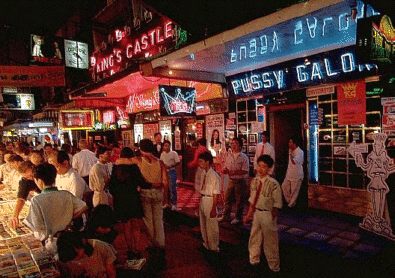
Abb.: Patpong Road, die Ausländersexmeile Bangkoks, Thailand (©Corbis)
Definition:
Sextouristen = Personen, die aus einem Industrieland kommend ein Zielland bereisen, sei's zu Urlaubszwecken, sei's als Geschäfts- oder Tagungsreisende, und dort Sex mit Einheimischen haben und dafür mit Geld oder Sachleistungen bezahlen.
Entgegen den Erwartungen ergab eine Sondererhebung bei der Reiseanalyse 1992, dass der Großteil des deutschen Sextourismus (auf ca. 800.000 Personen pro Jahr geschätzt) nicht nach Südostasien ging, sondern nach europäischen Reisezielen. Nur ein Viertel der Sexualkontakte mit Einheimischen fand in außereuropäischen Reisezielen statt.
Eine 1995 veröffentlichte Befragung von deutschsprachigen männlichen Sextouristen nach Thailand, Philippinen, Kenia, Dominikanische Republik bzw. Brasilien durch Kleiber & Wilke brachte u.a. folgende Ergebnisse:
Von den Befragten haben zwei Drittel ihre Reise individuell organisiert, nur ein Drittel waren Pauschalreisende, die meisten davon in die Dominikanische Republik. Die durchschnittliche Aufenthaltsdauer betrug 37 Tage. Das bedeutet, dass die Reiseveranstalter nur zum geringeren Teil am Sextourismus beteiligt sind.
»Die Beziehung zu Prostituierten sieht in den Gastländern ganz anders aus als zu Hause. In Deutschland dauert der Kontakt zu einer Prostituierten maximal eine Stunde und kostet im Schnitt 156 DM, ist in der Regel dominiert von der Prostituierten und -- mit genauen Tarifen für bestimmte Dienstleistungen -- vergleichsweise stark rationalisiert. In den typischen Zielgebieten für Sextouristen dagegen ist der Kontakt nicht auf die sexuelle Transaktion beschränkt, sondern eher in Urlaubsbeziehungen organisiert: Bei mehr als der Hälfte dauerte das »letzte Zusammensein mit der letzten Prostituierten« mindestens einen Tag, bei 45 Prozent mehrere Tage. Die sexuellen Kontakte beschränken sich dabei jedoch nicht auf eine Frau, sondern im Durchschnitt hatten die Männer zum Befragungszeitpunkt nach (wieder im Durchschnitt) 22 Aufenthaltstagen knapp vier verschiedene Sexualpartnerinnen, mit denen sie etwa 12 Sexualkontakte hatten. Dennoch: Ein Fünftel der Männer gaben an, sich in eine der Frauen »sehr stark« bzw. »stark« verliebt zu haben. Fast 30 Prozent haben sich »etwas« verliebt. Jeder zweite Mann erlebt also Aspekte von, wie immer zu bewertenden, Liebesbeziehungen in seinen Kontakten zu Prostituierten. Entsprechend spielen auch mehr als die Hälfte von ihnen mit dem Gedanken, diese Frau wiederzusehen, 20 Prozent sind sich sogar sicher und ein großer Teil gibt an, bereits über eine eventuelle Heirat nachgedacht zu haben." "Eine Zusammenfassung der Motive (mit Hilfe einer Faktorenanalyse) zeigt denn auch, dass der wichtigste Faktor aus Motiven besteht, die man mit »Verantwortungsfreier Sex mit jungen Mädchen« überschreiben kann. Dazu gehört die Zustimmung zu den folgenden Aussagen: »Ich hatte Sex mit einheimischen Frauen, weil
- ich Sex haben kann, ohne eine ernsthafte Beziehung eingehen zu müssen
- weil man alles bekommen kann, was man will
- weil Prostitution hier so billig ist
- weil ich hier anonym Sex haben kann und nicht kontrolliert werde
- weil ich hier Sex mit besonders jungen Frauen/Mädchen haben kann
- weil Sex mit Prostituierten hier so normal ist
- weil ich mich hier freier fühle im Ausleben meiner sexuellen Wünsche.«
Wer die sexuellen Dienstleistungen minderjähriger Mädchen kauft, das sind ca. 10 Prozent der männlichen heterosexuellen Sextouristen, ist nach den Ergebnissen der Studie im Durchschnitt älter als andere Sextouristen, ist sexuell noch aktiver, präferiert andere Sexualpraktiken und verliebt sich seltener."
[Mundt, Jörn W.: Einführung in den Tourismus. -- München [u.a.] : Oldenbourg, ©1998. -- ISBN 3486233661. -- S. 226 - 227. ]
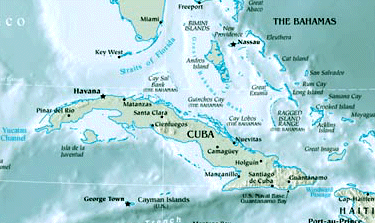
Abb.: Lage von Kuba (Quelle: CIA)
"HAVANA, Cuba - Facing troubling increases in HIV-positive cases and sexually transmitted diseases, Cuba is cracking down on prostitution at a beach resort that has become a notorious bastion of sex tourism. »We had the challenge of sanitizing Varadero . . . because the situation there already had achieved the character of an international scandal,« Prosecutor General Juan Escalona said. Reports from the resort 90 miles east of Havana say police are making nightly roundups of scores of prostitutes, keeping a list of apartments and houses where they take clients, and closing some of the rowdier bars. »There are very few jineteras around,« said one Varadero hotel employee, using the Cuban slang for prostitutes. »The bars and the beaches are almost empty. It is very sad.« Such glumness is a far cry from the recent Varadero scenes of young women aggressively propositioning dollar-carrying tourists, especially Europeans and Mexicans, at nightclubs and restaurants. Cocaine and marijuana were easily obtainable in Varadero, Cubans say, making the resort well known around the Western world as a place to find cheap male and female prostitutes, good food and warm waters. Cuban officials initially did little about the mushrooming prostitution, apparently trying not to disturb the island's 900,000-visitor-a-year tourism industry. Authorities made a run at Havana's estimated 6,000 prostitutes in December, driving them out of tourist hotels, arresting some of the more brazen ones on the seaside Malecon and keeping them moving on the notorious Fifth Avenue. But Varadero remained an enclave of relatively open prostitution until three weeks ago, when police launched the crackdown and health officials stepped up their commentaries on the health risks of prostitution. New HIV-positive cases reported in the first four months of this year rose to 80, compared with 34 during the same period last year, the head of a Havana AIDS sanatorium said last week in the Agenda Abierta radio program. And the number of gonorrhea and blennorrhea cases, both sexually transmitted diseases, rose from 34,223 in 1994 to 41,406 in 1995, Dr. Alfredo Abreu Daniel, chief of the National Group on Dermatology, said in February. This in a country that took draconian steps to prevent the spread of AIDS, such as confining HIV-positive patients to sanatoriums, and achieved one of the world's lowest growth rates in cases. »We don't want to waste the extraordinary effort the country is making in the prevention of AIDS and venereal diseases,« Prosecutor General Escalona said. A new penal code under consideration, Mr. Escalona said, will tighten sanctions on pimps and others who live off prostitution, such as taxi drivers; increase jail terms when the cases involve minors; and allow the seizure of homes used by jineteras. While the increases in HIV-positive cases and other sexually transmitted diseases might seem significant, health experts cautioned that the numbers point to a still-small incidence of such diseases in Cuba. Cuba has reported a total of only 1,600 HIV-positive patients and 400 AIDS deaths. ....
Cuba needs 160 million condoms a year but can afford only 43 million, Health Minister Carlos Dotres said in Spain last month. He blamed the problem on the U.S. trade embargo....
While officials initially regarded prostitution as an unavoidable byproduct of Cuba's opening to Western tourism, the increases in sexually transmitted diseases and the negative publicity of sex tourism have clearly irked leaders in Havana.
Cuban President Fidel Castro complained at the start of the Varadero campaign last month that prostitution, drugs and other crime - problems increasing for several years - »are inadmissible in a socialist society."
[Tamayo, Juan O.: Cuba cracking down on prostitution at beach resort: Sexually transmitted diseases have been increasing. -- In: The Dallas Morning News. -- 9 Jun 1996, pp. 27A.]

Abb.: Thai-Prostituierte
[Bildquelle: http://redes.ucpel.tche.br/extropia/temp/selena/struggle/thailand.html.
-- Zugriff am 2000-07-27]
"Hinsichtlich der Fragestellung, welche Beziehungsformen Männer anstreben, die als Prostitutionstouristen z.B. nach Thailand reisen, sind folgende Ergebnisse festzuhalten. Entgegen der allgemeinen Meinung, alle Prostitutionstouristen suchten in den Zielländern nur den kurzen sexuellen Kontakt zu den einheimischen Prostituierten, zeigt sich, dass die Männer durchaus unterschiedliche Beziehungen anstreben, die in ihrer Bandbreite denen entsprechen, die die Männer auch zu den Frauen ihrer Heimatländer suchen. Unterschiedlich ist lediglich die prozentuale Verteilung.
- Wie nicht anders zu erwarten, sucht die größte Gruppe der Prostitutionstouristen nach kurzen sexuellen Kontakten (ca. 40%). Der sexuelle Kontakt zu den einheimischen Prostituierten wird in diesem Fall als integraler Bestandteil der 'Urlaubsfreuden' gesehen, als das 'Bonbon', das Thailand, anders als andere Urlaubsländer, dem westlichen Mann für dessen Regeneration mitliefert.
- Die zweitgrößte Gruppe sind Männer, die sich längerfristig eine Prostituierte kaufen. Auch sie empfinden es als 'normal', dass ihnen in Thailand überall und jederzeit entsprechend ihren Wünschen eine Frau zur Verfügung steht. Für sie ist jedoch neben der sexuellen Betätigung und Bestätigung auch und vor allem der Aspekt wichtig, in der Prostituierten eine zuverlässige Reisebegleiterin zu haben, die sie rund um die Uhr 'betreut'.
- Die drittgrößte Gruppe westlicher Freier sucht nach einer Lebenspartnerin unter den thailändischen Prostituierten. Diese Männer erhoffen sich von den Frauen 'wahre Liebe' und umfassendes Akzeptiertwerden, was sie von dem in Europa kreierten Klischee der familienbezogenen, immer freundlich lächelnden Asiatin ableiten.
- Eine vierte Gruppe hofft in Thailand die 'besondere Frau' zu finden, die ihnen aufgrund ihrer umfassenden 'Andersheit' eine noch 'heile' Welt im zwischengeschlechtlichen Bereich zu bieten scheint.
- Und schließlich gibt es eine relativ kleine Gruppe von meist jüngeren Erstbesuchern, die ursprünglich tatsächlich nicht vorhaben, sich prostitutionstouristisch zu verhalten, dann aber doch eine Prostituierte kaufen. Meist wird dies mit Kontrollverlust u.a. aufgrund von massivem Alkoholgenuss begründet. Ich bezeichne diese Männer als die 'Hineingerutschten'.
Diese Einteilung in Gruppen bedeutet nicht, dass ein Mann permanent und unveränderbar einer Gruppe zugehören muss. Vielmehr kommt es vor, dass ein und derselbe Mann während eines Urlaubs oder im Laufe wiederholter Besuche seine prostitutionstouristischen Ambitionen wechselt oder anders gewichtet. So neigten beispielsweise einige der Prostitutionstouristen, die vormals kurze sexuelle Kontakte zu den thailändischen Prostituierten gesucht hatten, dazu, sich nach einigen Jahren eher jeweils eine 'feste' Prostituierte für die gesamte Zeit des Urlaubs zu suchen. Sie meinten, sie hätten keine Lust mehr auf die allabendliche 'Anmache'. Andere, die 'eigentlich' eine Lebenspartnerin suchten, also eine langfristige Beziehung anstrebten, wechselten 'ihre' Prostituierte zum Teil alle paar Tage, weil sie der Meinung waren, es sei (noch) nicht die 'Richtige'.
Da die Männer diese vielseitigen und in vielen Fällen auf Dauer angelegten Beziehungswünsche an eine ausländische Frau richten, deren Sprache sie selten sprechen, deren Kultur und Weltverständnis von unserem grundlegend verschieden ist und die zudem aus einem sehr schwierigen Milieu, der Prostitution, kommt, interessierte mich, was die westlichen Männer mit ihren Beziehungswünschen zu den thailändischen Prostituierten assoziieren. Die Hoffnungen, die alle Prostitutionstouristen (unabhängig davon, welche Beziehungsform sie anstreben) mit ihrem Handeln assoziieren, verweisen auf paradoxe und - im Zusammenhang mit Prostitutionstourismus - unerfüllbare Wünsche. Sie wollen einerseits völlige Kontrolle haben und als die Mächtigeren anerkannt werden, andererseits wünschen sie sich in vielen Fällen Geborgenheit, Liebe und umfassendes Akzeptiertwerden von den Prostituierten der Zielländer. Hinzu kommt die Vorstellung, mit einer thailändischen Prostituierten könnte man(n) unkomplizierten Sex haben. Sehr wichtig ist den meisten Prostitutionstouristen auch die Bequemlichkeit und die Möglichkeit völlig passiv zu bleiben und sich ausschließlich auf den eigenen Konsum konzentrieren zu müssen. Zumal sie dies in den einschlägigen Ländern zu Preisen bekommen, die sich letztlich jeder westliche Mann spielend leisten kann. Nicht für alle, aber doch für eine nicht unerhebliche Zahl von Prostitutionstouristen, spielen darüber hinaus folgende Aspekte eine zentrale Rolle: die Sicherheit, die sie durch die Begleitung einer thailändischen Prostituierten, also einer Einheimischen, haben sowie die Möglichkeit mit Hilfe der Fremdheit der Frauen eine Distanz zu schaffen, die die Zurückweisung jeglicher Verantwortung für das eigene Handeln erleichtert. Auch die Suche nach der 'wahren Liebe' der als anhänglich und fürsorglich geltenden Thailänderin ist für einige Prostitutionstouristen ein wichtiges Thema, obwohl dies im Zusammenhang mit Prostitution wie ein Paradoxon anmuten muss. In den von den Männern angestrebten Beziehungen geht es letztlich nicht um auf Gleichberechtigung ausgerichtete Partnerschaftsstrukturen. In dieser Situation kommt ihnen die Institution Prostitution als ultimativer Dienstleistungsbetrieb entgegen. Nur in dieser 'gekauften Beziehung' ist eine totale Unterdrückung und Kontrolle der Persönlichkeit der weiblichen Person durchsetzbar. Gleichzeitig ist es kaum möglich, dass der Mann die Kontrolle über die Beziehung oder seine Gefühle verliert. Die Frau ist reduziert auf einen repräsentativen Gegenstand, der sich dem Willen des Mannes unterwirft, seiner Lust dient und sein Ansehen gegenüber anderen Männern steigert.
Die oben dargestellten Erwartungen der betroffenen Männer verweisen denn auch auf starke Kontrollverlustängste. Es lässt sich feststellen, dass der Prostitutionstourismus für viele Männer einen Versuch darstellt, in den Zielländern ihrer Reise ein Maß an Macht und Kontrolle zu bekommen oder wiederzuerlangen, dass sie in ihren Heimatländern nicht oder nicht mehr haben. Diese Macht bezieht sich sowohl auf ihr Mann-Sein wie auch auf ihre Zugehörigkeit zu einem reichen, westlichen Industrieland.
Soweit zu den Hoffnungen der Prostitutionstouristen. Wie steht es demgegenüber mit den realen Erfahrungen der betroffenen Männer? Erfüllt sich das Versprechen, dass für Männer im Prostitutionstourismus alle Träume wahr werden? Das zentrale Ergebnis der Gegenüberstellung der Wunschvorstellungen und der realen Erfahrungen der Prostitutionstouristen zeigt, dass dieses Paradoxon nicht aufzulösen ist, letztlich also fast keiner der betroffenen Männer in den Zielländern findet was er sucht. Weder erfüllt sich der Wunsch nach der wie auch immer gearteten 'perfekten' Beziehung, und auch der Sex mit der thailändischen Prostituierten hält nur quantitativ alle Rekorde. Qualitativ, also gefühlsmäßig, wird er von den Männern meist als langweilig, unschön oder sogar abstoßend empfunden. Wenn aber nicht einmal mehr Männer in einer derart exponierten Stellung als Männer Zufriedenheit finden, verweist das auf tiefgreifende Brüche im System der männlichen, hegemonialen Macht, was weitreichende gesellschaftliche und machtpolitische Folgen hat. Maßnahmen gegen das prostitutionstouristische Verhalten westlicher Männer sollten u.a. an diesem Punkt ansetzen und im Vorfeld, also präventiv, darauf hinwirken, dass der Mythos zerstört wird und die Realität ins Bewusstsein der westlichen Männer dringt. Hier geht es gleichermaßen um Aufklärung und um Desillusionierung."
[Rothe, Andrea <1964 - >: Männer -- Prostitution -- Tourismus : wenn Herren reisen. -- Münster : Westfälisches Dampfboot, ©1997. -- ISBN 3896914081. -- S. 185 - 188.]
"Pädophile oder ihre Sympathisanten haben gemeinsam kleine Hotels, Ferienhäuser oder Gästehäuser in ruhigen Ferienzentren überall in Asien erworben, insbesondere in Sri Lanka, in den Philippinen und in Thailand, und aus Übersee kommende Pädophilengruppen werden dort, den jeweiligen Wünschen und Erfordernissen entsprechend, mit einer Auswahl von Jungen und Mädchen versorgt. Oft genug kann das Reiseunternehmen Fotos und Beschreibungen der Kinder liefern, ehe die Touristen ihre Heimatstadt überhaupt verlassen. Wie bereits . . . beschrieben, haben von Päderasten betriebene Organisationen Heime und Waisenhäuser für Straßenkinder eingerichtet, die als Deckmantel für die Versorgung von Überseetouristen mit Kinderprostituierten dienen . . . '' [O'Grady, Ron: Gebrochene Rosen : Kinderprostitution und Tourismus in Asien. -- Unkel/Rhein [u.a.] : Horlemann, 1992 -- ISBN 3927905518. -- S. 82. -- Originaltitel: Einheitssacht.: The child and the tourist]
"Prostitutionstouristinnen scheinen eine zahlenmäßig fast unscheinbar kleine Gruppe darzustellen. »Im Hinblick auf das Geschlecht lässt sich sagen, dass der Prostitutionstourismus eine überwiegend männliche Domäne ist. Obwohl in den vergangenen Jahren des öfteren Berichte über das sextouristische »Studienrätinnen-Dorado« Kenia erschienen sind, ist die weibliche Prostitutionstouristin in Mombasa eher eine Randerscheinung. Andererseits ist nicht zu übersehen, dass einige junge Kenianer (zum Teil indischer Abstammung) sich dieser Zielgruppe annehmen: Wiederholt haben wir beobachtet, wie diese in Hotels und Diskotheken zu Touristinnen ohne (männliche) Begleitung (zum Teil) erfolgreich Kontakt suchen. Insgesamt kann man aber wohl feststellen, dass der weibliche Prostitutionstourismus in den Medien eine (im Vergleich zum realen Stellenwert) eher überproportionale Beachtung gefunden hat. In Nachtclubs sind zwar häufig gutaussehende weiße »Touristinnen« ohne Begleitung zu beobachten, doch handelt es sich dabei oftmals um Prostituierte, die dort (als »Exotinnen«) von begüterten Schwarzen, Asiaten und Indern - seltener wohl von Prostitutionstouristen nachgefragt werden. Wir vermuten aber, dass Prostitutionstouristinnen ihre Urlaubsbeziehungen öffentlich weniger augenfällig zur Schau stellen und/oder diese eher als »normalen« Urlaubsflirt interpretieren.« Tatsache ist, dass über einen real existierenden weiblichen Prostitutionstourismus wenig Wissen besteht. »Unseres Wissens«, so Gaby Beckmann und Barbara Elzer in ihrer »Wahrnehmung des Phänomens«, »gibt es keine wissenschaftliche Studien zum Thema Frauen-Sextourismus, keine Daten, die Rückschlüsse auf das Ausmaß zuließen, keine Forschung zur Motivation der Frauen oder zu Ausprägungsformen, kaum Hintergrundinformationen zu den männlichen Anbietern von sexuellen Dienstleistungen und so weiter.« Dabei gibt es Hinweise darauf, dass das Phänomen bereits in den sechziger Jahren erkennbar war, wobei die Grenzen zwischen einer gezielten beziehungsweise gewünschten Kontaktaufnahme und einer eventuellen erfolgreichen »Anmache« jedoch fließend zu sein scheinen .
Deutlicher werden die sexuellen Motive alleinreisender Frauen in bestimmten Trends der siebziger Jahre, als sich zum Beispiel die Karibik als Ziel eines »unbeschwerten« Urlaubsvergnügens empfahl beziehungsweise über die Medien offeriert wurde. Hinweise auf weiblichen Prostitutionstourismus finden sich darüber hinaus auch bei Berit Latza, die in »Sextourismus in Südostasien« als neuen Trend bezeichnet, dass »mittlerweile auch eine kleine Anzahl weißer Touristinnen männliche Prostituierte in Anspruch nehmen«. Darüber hinaus scheint sich Bali als Ziel vor allem australischer Prostitutionstouristinnen entwickelt zu haben, während die deutschen Prostitutionstouristinnen offenbar Kenia, zunehmend jedoch auch Lateinamerika (Brasilien, die Dominikanische Republik, Costa Rica) bevorzugen."
[Wuttke, Gisela: Kinderprostitution, Kinderpornographie, Tourismus. -- Göttingen : Lamuv, ©1998. -- ISBN 3889775314. -- S. 91 - 92 (dort Quellennachweise).]
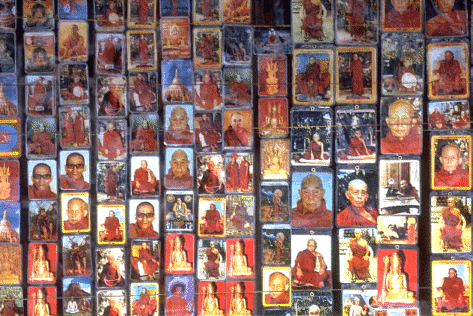
Abb:: Buddhistischer Devotionalienladen, u.a. mit Porträts bekannter
buddhistischer Äbte, Maha Bandoola Markt, Yangon, Myanmar (©Corbis)
Christian Gottlieb Schmidt über eine Reise 1 7 86/8 7 zum Wallfahrtsort Maria Einsiedeln in der Schweiz, aus seinem Bericht Von der Schweiz : Journal meiner Reise 1786/87: Den ersten Teil des Weges ab Zürich legte er mit dem Schiff zurück, zusammen mit einer «rohen Horde» von 40 Pilgern. Ab Richterswil ging's dann zu Fuß weiter. Schmidt ließ sich über die vielen Wallfahrer aus und konnte aus ökonomischen Überlegungen nicht verstehen. «dass die armen Bauern und Bürgerleute eben zur Zeit der nötigsten Arbeit mit großem Geldaufwand und Zeitverlust eine so weite, unnütze Reise auf Verordnung der Seelenärzte tun müssen. Reiche Leute haben es bequem, denn die können jemand diese Wallfahrt für sich machen lassen und ihn dafür bezahlen.» Er stellte auch fest, dass, «sobald man den ganz katholisch-demokratischen Kanton Schwyz zu betreten angefangen, so hört auch schon fast alle Kultur auf, das Land ist weniger bebaut, Fruchtfelder sind selten». Einsiedeln beschrieb er als Städtchen. in welchem fast alle Häuser Gasthäuser seien, und der Wirt zum Engel habe unter das Schild noch folgenden Hinweis aufgeführt: «Bonne Hotellerie pour Messieurs les François & à pied & à cheval». Das Benediktiner-Kloster sei das reichste in Teutschland -- er sagte ausdrücklich Teutschland. denn der Abt sei allemal Reichsfürst und habe Sitz und Stimme auf dein Reichstag. Es seien etwa 80 geschorene Köpfe im Kloster. «welche sich von dessen fetten Einkünften trefflich mästen», aber auch viel Arbeit hätten, denn alle Pilger, die hierher kämen. würden auch beichten. Aus seinen Bemerkungen geht hervor, dass er jedenfalls nicht viel von der katholischen Kirche hielt. Aufgefallen sind ihm auch die über 100 Boutiquen. «wo man geistliche Schnurpfeifereien wie Rosenkränze, Amulette, Skapuliere, geweihte Kerzen usw. feil hat». Wie schlecht die Polizei sein müsse, ersehe man aus der entsetzlichen Menge von Bettlern. besonders Kindern,. die einem auf dem Weg anfielen. «Schon viele Schritte zuvor ehe man an sie kommt, schreien sie einen an. ja sie fallen sogar recht abgefeimt auf die Knie und beten»."
[Wyler, Theo <1943 - >: Als die Echos noch gepachtet wurden : aus den Anfängen des Tourismus in der Schweinz. -- Zürich : NZZ, ©2000. -- ISBN 3858238252. -- S. 69. ]
Pilgertourismus ist die älteste Form des Massentourismus. Alle großen Religionen haben ihre Wallfahrtsorte. Einer der am eindrucksvollsten gemanagten ist der vischnuitische Wallfahrtsort Tirupati in Karnataka, Indien
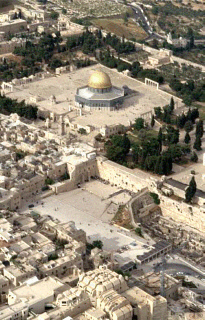
Abb.: Tempelberg, Jerusalem, ca. 1991: The Temple Mount precinct of the
Old City of Jerusalem. The Dome of the Rock, one of the holiest shrines in
Islam, stands on the top of the Temple Mount, while the Western, or Wailing,
Wall, sacred to Jews, is below it (©CORBIS )
Islam:
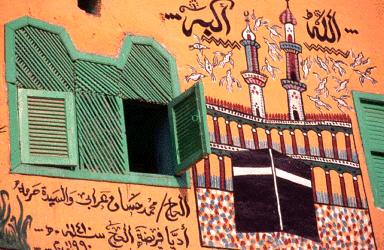
Abb.: Malerei am Haus eines Hajji, eines Pilgers nach Mekka und Medina,
zur Erinnerung an die Pilgerfahrt: man sieht die Kaaba, Luxoe, Ägypten (©CORBIS)
Katholizismus: z.B. Nuestra Señora de Guadalupe, Mexiko, Patronin der Amerikas:
|
|
|
Buddhismus: Yahoo category: http://dir.yahoo.com/Business_and_Economy/Shopping_and_Services/Travel_and_Transportation/Tour_Operators/Religious_and_Self_Discovery/Buddhist/. -- Zugriff am 2001-02-23
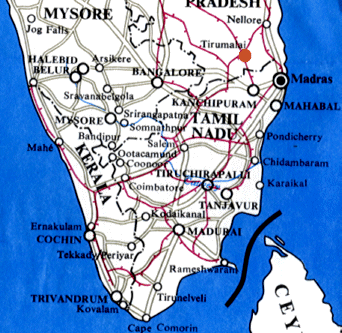
Abb.: Lage von Tirupati
Tirupati ist einer der von Hindus für am heiligsten gehaltenen Orte Südindiens. Das Heiligtum von Tirupati ist der am meisten besuchte Wallfahrtsort Südindiens und die reichste religiöse Institution Indiens. Die folgenden Auszüge aus der Webpräsenz Tirupatis [http://www.tirumala.org. -- Zugriff am 2001-02-23] geben einen guten Überblick über die wirtschaftliche Bedeutung und die professionelle Führung dieses Ortes des Pilgertourismus:
|
|
|
The ancient and sacred temple of Sri Venkateswara is located on the seventh peak, Venkatachala (Venkata Hill) of the Tirupati Hill, and lies on the southern banks of Sri Swami Pushkarini. It is by the Lord’s presidency over Venkatachala, that He has received the appellation, Venkateswara (Lord of the Venkata Hill). He is also called the Lord of the Seven Hills.
The temple of Sri Venkateswara has acquired unique sanctity in Indian religious lore. The Sastras, Puranas, Sthala Mahatyams and Alwar hymns unequivocally declare that, in the Kali Yuga, one can attain mukti, only by worshipping Venkata Nayaka or Sri Venkateswara.
The benefits acquired by a pilgrimage to Venkatachala are mentioned in Rig veda and Asthadasa Puranas. In these epics, Sri Venkateswara is described as the great bestower of boons. There are several legends associated with the manifestation of the Lord at Tirumala.
The temple has its origins in Vaishnavism an ancient religion which advocates the principles of equality and love, and prohibits animal sacrifice.
The sanctum sanctorum which houses the awe-inspiring idol of the Lord of the Seven Hills is situated in the main temple complex of Tirumala.
[Quelle: http://www.tirumala.org/srivenk_about_p7.htm. -- Zugriff am 2000-07-12]
Sri Venkatachala Mahatmya is referred to in several Puranas, of which the most important are the Varaha Purana and the Bhavishyottara Purana. The printed work contains extracts from the Varaha Purana, Padma Purana, Garuda Purana, Brahmanda Purana, Markandeya Purana, Harivamsa, Vamana Purana, Brahma Purana, Brahmottara Purana, Aditya Purana, Skanda Purana and Bhavishyottara Purana. Most of these extracts describe the sanctity and antiquity of the hills around Tirumala and the numerous teerthams situated on them.
The legends taken from the Venkatachala Mahatmya and the Varaha Purana, pertaining to the manifestation of the Lord in Tirupati, are of particular interest.
About the Temple of Sri Venkateswara
According to the Varaha Purana, Audi Varaha manifested Himself on the west bank of the Swami Pushkarini, while Vishnu in the form of Venkateswara came to reside on the south bank of the Swami Pushkarini.
One day, Rangadasa, a staunch devotee of Vishnu, in the course of his pilgrimage, joined Vaikhanasa Gopinatha, who was going up the Tirumala Hill for the daily worship of Lord Venkateswara. After bathing in the Swami Pushkarini, he beheld the lotus-eyed and blue-bodied Vishnu beneath a tamarind tree. Vishnu was exposed to the sun, wind and rain and was only protected by the extended wings of Garuda.
Rangadasa was astounded by the wonderful sight. He raised a rough wall of stones around the deity, and started supplying flowers faithfully to Gopinatha everyday for Vishnu's worship.
One day, Rangadasa was distracted by a Gandharva king and his ladies. Consequently, he forgot to supply flowers to Gopinatha for Vishnu's worship. The Lord then revealed Himself and told Rangadasa that He had been testing the latter's continence, but Rangadasa had not been steadfast and had succumbed to temptation.
However, the Lord accepted and appreciated Rangadasa's devoted service to Him till then, and blessed Rangadasa that he would be reborn as an affluent ruler of a province and would enjoy the earthly pleasures. He would continue to serve the Lord, construct a beautiful temple with a vimana and high surrounding walls, and thereby earn eternal glory.
Rangadasa was reborn as Tondaman, the son of the royal couple, Suvira and Nandini. Tondaman enjoyed a pleasurable life as a young man. One day, he set out on a hunting expedition on the Tirumala Hill, and with the help of a forester, saw Vishnu under the tamarind tree. Tondaman returned home, deeply affected by the vision of Vishnu.
Tondaman later inherited his father's kingdom, Tondamandalam. In accordance with the directions given by Audi Varaha to a forester, Tondaman constructed a prakaram and dvara gopura, and arranged for regular worship of the Lord (according to Vaikhanasa Agama).
In the Kali Yuga, Akasaraja came to rule over Tondamandalam. His daughter Padmavathi was married to Venkateswara. The marriage, officiated by Brahma, was celebrated with great pomp and splendour.
[Quelle: http://www.tirumala.org/srivenk_about_p7.htm. -- Zugriff am 2000-07-12]
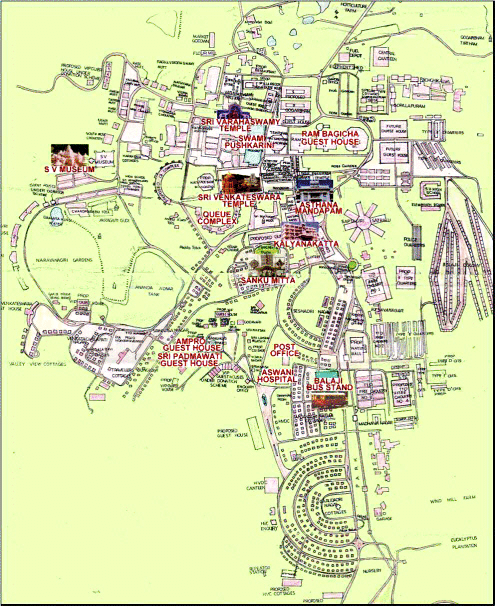
Abb.: Übersichtsplan von Tirupati
In 1933, the Madras Legislature passed a special act, which empowered the Tirumala Tirupati Devasthanams (TTD) Committee to control and administer a fixed group of temples in the Tirumala-Tirupati area, through a Commissioner appointed by the Government of Madras. This committee was assisted by a Religious Advisory Council for religious matters and a Ryots Advisory Council for the management of TTD's estates. In 1951, the Act of 1933 was replaced by an enactment whereby the administration of TTD was entrusted to a Board of Trustees, and an Executive Officer was appointed by the Government .
The provisions of the Act of 1951 were retained by Charitable and Religious Endowments Act, 1966.
Abb.: TTD Administrative OfficeToday, TTD is a conglomeration of temples, brought under the First Schedule 2 of the Act 30 of 1987. The Board of Trustees is constituted by members appointed by the government
The Executive Officer is the chief executive of TTD. He is assisted by two Joint Executive Officers, Chief Vigilance and Security Officer, Conservator of Forests, Financial Advisor and Chief Accounts Officer and Chief Engineer. Besides, there are officials to look after the different branches of administration.
TTD maintains 12 temples and their sub-shrines, and employs about 14,000 persons.
Objectives
Tirumala Tirupati Devasthanams have dedicated themselves to serving the pilgrims who visit Tirumala. It provides facilities for making their pilgrimage a unique and rewarding spiritual experience. It also works towards preserving the serenity and sanctity of the sacred Tirumala-Tirupati area.
TTD is ever-conscious of the social, economic, religious and environmental needs of the people, especially the needy. It undertakes several activities and has initiated different schemes in these areas.
[Quelle: http://www.tirumala.org/about_p7.htm. -- Zugriff am 2000-07-12]
Sarvadarsanam Special DarshanSarvadarsanam means 'darshan for all'. Pilgrims can have a Sarvadarsanam of Lord Sri Venkateswara from: 0730 hrs till the entrance to the Sarvadarsanam queue is closed, on all days except Wednesday, Thursday and Friday. On ordinary days, about 18 hours are allotted for Sarvadarsanam and on peak days, it it is open for 20 hours. The entrance for Sarvadarsanam is through the Vaikuntam Queue Complex. Around 50,000 pilgrims visit during a day.
Queue ComplexThere is a separate Special Darshan queue for pilgrims. There are two categories of special darsanam. In one category pilgrims have to pay Rs.40 and Rs.50 for other category. Those who pay Rs.40 will be given one laddu [25 Gramm] free apart from darshan and those who pay Rs.50 will be given two laddus [50 Gramm] after allowing them for darshan. The darshan timings are the same as that for Sarvadarsanam. The entrance is through the PPC (queue complex). The queue merges with the Sarvadarsanam queue at Bangaruvakili. Pilgrims who use this facility will be able to reach the main entrance faster than the pilgrims who use the Sarvadarsanam queue.
Abb.: WarteschlangeThe number of pilgrims visiting Tirumala-Tirupati are increasing every year. To avoid stampedes, TTD has constructed the Vaikuntam Queue Complex, which is a series of inter-connected halls that lead to the main temple. An efficient queue system ensures that pilgrims move in an orderly fashion through the Queue Complex, towards the main temple. The halls in the Queue Complex are clean, spacious and airy. TTD provides a wide range of facilities in the Queue Complex:
- Canteen services. Food packets are sold at subsidised rates.
- Sale of pure milk by the Andhra Pradesh Dairy Development Corporation.
- Medical aid
- Sale of photographs, calendars and other TTD publications
- Toilets
- Closed Circuit Television, through which devotional programmes and music are relayed
- Cloak rooms near the Vaikuntam Queue Complex
- Places where footwear can be deposited, free of cost (at the entrance to the queue halls)
- An officer positioned at the entrance to the temple (Mahadwaram) to regulate the queue and attend to complaints.
- An officer to look after the comforts and facilities of the pilgrims in the Vaikuntam Queue Complex.
Sudarsanam
Sudarsanam token is introduced with a view to have both free and paid darsan of Sri Venkateswara Swami minimizing the waiting time of the devotees in the queue compartments.
- These tokens are available free of cost at first Choultry (Opp. Railway Station), second Choultry (Behind Railway Station), Alipiri Bus Stand, Tirupatiand at Vaikumtam Q Complex , Pilgrim Amenities Centre (Near C.R.O) and near Rambagicha Guest House at Tirumala.
- The time of darsan is indicated on the tokens.
- If the devotees enter the Q Complexes at Tirumala at the time indicated on the tokens, they will be allowed for darsan duly examining their tokens.
- The devotees can have darsan within two hours after entering the Q Complex.
- As this system saves much time, it provides ample opportunity to the pilgrims to visit the sacred Temples like Sri Govindarajaswami Temple and Kapilatirtham at Tirupati, Sri PadmavathiAmmavari Temple at Tiruchanur, Sri Kalyana Venkateswara Swami Temple at Srinivasa Mangapuram and other important pilgrim centreson package tour.
- Tokens are issued for each and every individuals and not for groups.
Precautions to be taken
Special Darshan for the Physically Disabled and the Aged
- Sudarsanam token should be taken from Tirumala Tirupati Devasthanams Counters. Token taken from elsewhere will not be accepted.
- Tokens tied on the wrist should not be removed until the darsan is completed.
- Tokens should not be exchanged.
- Don't trust dalaris or touts.
- Devotees may contact their nearest T.T.D. Information Centre for further details.
This darshan is arranged for the physically disabled and the aged directly through a separate gate at Maha Dwaram, the main temple entrance. They can be accompanied by an attendant, if found necessary.
[Quelle: http://www.tirumala.org/srivenk_darshan_p7.htm. -- Zugriff am 2000-07-12]
Walking up the Hills TonsuringMany pilgrims walk up the hills to fulfil vows they have taken. According to the Varaha Purana, climbing the Tirumala Hill with a deep sense of devotion will result in the Lord bestowing:
- the lame with strength of legs and rapidity of motion
- the blind with vision and clear, lotus-like eyes
- the dumb with learning and wisdom
- the deaf with sound and sharp hearing
- sterile women with children
- the poor with wealth
Tirumala Tirupati Devasthanams (TTD) provides the following facilities for pilgrims who walk up the hills.
- Transportation of luggage, free of cost, to Tirumala. Pilgrims will be given a token when they deposit their luggage at any of the choultries [Ruhehallen] in Tirupati, or at the Toll Gate at Alipiri. They can take delivery of the luggage at the Central Reception Office Counter at Tirumala.
- Drinking water along the footpath.
- Toilets
- Shelters at important points along the way for resting
- Constant patrol by security guards, gurkhas and the police to prevent unwary pilgrims from being cheated or being robbed by unscrupulous elements.
- Relay of religious programmes through the local broadcasting system.
- Medical facilities at fixed locations
- Canteens that supply refreshments.
AngapradakshinamThe objective behind tonsuring (shaving one's head for the Lord) is to demonstrate that he/she completely surrenders his/her ego at the feet of the Lord. Pilgrims can have their heads tonsured at the Kalyanakatta (opposite the Annanadanam complex) Pilgrims can also request to be tonsured at the cottages, where 17 sub-centres are arranged for tonsuring.
TulabharamAngapradakshinam is when pilgrims lie prostrate, and then roll around the temple, chanting the Lord's name. The objective is to show their devotion to the Lord, and thank Him for protecting them. Pilgrims who wish to undertake the Angapradakshinam have to take a dip in the Swami Pushkarini, and reach the temple complex by 0200 hrs (through a special queue that starts from the PPC sheds). Angapradakshinam is performed in the Vimana Pradakshinam, one of the pathways around the temple. Usually the Angapradakshinam will be restricted at week ends i.e. Saturday and Sunday. No darshan of the Lord to Usually the Angapradakshinam devotees at the time of Angapradakshinam on Friday. Angapradakshinam will be restricted when there is heavy influx of pilgrims to Tirumala.
NiluvudopidiTulabharam is offering one's weight in coins or other items such as sugar, candy according to one's vows to the Lord. Tulabharam is generally performed for children. Pilgrims can weigh their offerings in the temple complex. The coins can be deposited in the temple hundi and other items can be handed over to the temple--- at Tulabharam. The queue for Tulabharam is the regular queue that starts from the Vaikuntam Queue Complex or PC Queue Complex.
Niluvudopidi is offering to the Lord the ornaments, etc., that one is wearing when one takes the vow. The objective is to sacrifice one's belongings to the Lord, with the philosophy 'what is mine is the Lord's'.
[Quelle: http://www.tirumala.org/faci_vows_p7.htm. -- Zugriff am 2000-07-12]
TTD has initiated several schemes to cater to the demands of the increasing influx of pilgrims to Tirumala, support the economically-backward and improve the environment in and around Tirumala. Sri Venkateswara Nitya Laddu Danam Scheme
Sri Venkateswara Nitya Laddu Danam Scheme was started in 1981. Under this scheme, TTD distributes a laddu (25 gm) to each pilgrim, free of cost. Under this scheme, a donation of Rs 1 lakh [100,000] or above is accepted as endowment. The interest on the deposits is used for the preparation and free distribution of 25,000 laddus of 25 gm each in the donors' name on the day of their choice.Sri Venkateswara Nitya Annadanam SchemeTTD has envisaged the Sri Venkateswara Nithya Annadanam Scheme to provide free meals to the poor in Tirumala. The scheme has received overwhelming support from philanthropists across the world. The scheme was started on a small scale in 1984, with food being served to around 2,000 persons a day. Today, free food is served to a minimum of 15,000 poor people a day. The number increases to about 25,000 to 30,000 a day during festivals and other important occasions. The minimum contribution for the scheme is Rs. 1,000, and further, in multiples thereof, deposits the entire amounts in a nationalised bank. The interest earned is utilised towards the scheme.
Sri Padmavati Ammavari Nitya Annaprasada Scheme
The objective of the scheme is to distribute prasadams to the Visiting pilgrims free of cost continuously right from the opening of the temple doors till the closing of the temple doors daily. The devotees who want to contribute to the scheme may pay a sum of Rs. 50,000/- ( Rupees fifty thousands only) or multiples thereof to this scheme . The devotees can also contribute a sum of Rs.1000/- (Rupees one thousand only) Or multiples there of to Sri Padmavathi Ammavari Nitya Annaprasada Scheme. The minimum donation accepted for the scheme is Rs 1000/- ( Rupees one thousand only).
Sri Venkateswara Vanabhivruddhi Scheme
The sacred forests of Tirumala are Lord Sri Venkateswara's precious gift to mankind. With a view to protect and maintain the ecological balance in the area, TTD has introduced Sri Venkateswara Vanabhivruddhi Schemes. The schemes provide an opportunity to the public to participate in a massive afforestation project implemented by the Forest Department of TTD. The details are as follows:
- Vriksha Samvardhanam: About 500 plants will be planted in Tirumala. Donation Amount: Rs. 25,000
- Vriksha Prasadam: Under this scheme, 100 fruit and flower seedlings will be raised and distributed to pilgrims in the name of the Donor for a period of ten years, to the general public on the seven sacred hills. Donation Amount: Rs. 15, 000
- Smaraka Vanalu: Under this scheme, 10 saplings of a selected species will be planted in a grove on the sacred seven hills and maintained for five years. Donation Amount: Rs. 5,000
- Vana Samrakshana Bhagaswamyam: This scheme has been proposed to protect and improve the forest cover on the seven hills. Donation Amount: Rs. 2,000
- Vriksha Vardhini: 2000 plants will be planted once in the sacred hills of Tirumala and plantation will be named after donor or person of his choice name. Plantation will be maintained for 5 Years. Donation Amount: Rs. 5 Lakhs [500,000] and above
- Vriksha Pravardhini: 1000 plants will be planted once in the sacred hills of Tirumala once.Donation Amount: Rs.1 Lakh [100,000] by a single donor and above upto 5 Lakhs [500,000].
Sri Balaji Institute of Surgery, Research and Rehabilitation for the Disabled (B.I.R.R.D.) Scheme
Sri Balaji Institute of Surgery, Research and Rehabilitation for the Disabled (BIRRD) is a premier medical institute, that treats patients suffering from polio myelitis, cerebral palsy, congenital anomalies, spinal injuries, and the orthopaedically handicapped. It comprises a centrally air-conditioned hospital with the latest medical equipment, built by TTD at a cost of Rs. 4.5 crore [45,000,000]. BIRRD makes use of state-of-the-art medical technology and provides services to the poor, at no cost. It also distributes artificial limbs, calipers and aids, free of cost, to the needy and the poor. The endowment amount is Rs. 6000. TTD accepts donations towards the BIRRD Scheme.
Cottage Donation Scheme
There is a steady influx of pilgrims to Tirumala every year. To meet the demand for accommodation, TTD constructs cottages, guest houses and choultries [Ruhehallen] in Tirumala. In response to the request of many philanthropists, TTD has launched a donation scheme for constructing units of accommodation like cottages and guest houses. There are several categories of construction proposed by TTD under this Cottage Donation Scheme.
- Garudadri Nagar Cottages at Tirumala - Construction of the First Floors. Donation amount: Rs. 225,000
- Guest Houses
- Sapthagiri Satramulu: furnished suites. Donation amount: Rs. 150,000
- Special-type Cottages: three floors. Donation amount: For each floor: Rs. 5 lakh. [500,000]
Udayasthamana Sarva Seva Scheme
Under this scheme, all donors are permitted to attend all rituals and sevas for Lord Sri Venkateswara on the day of their choice. The endowment amount is Rs.1 lakh [100,000]. If the seva is to be performed on Friday, the endowment amount is Rs. 3 lakhs [300,000].
[Quelle: http://www.tirumala.org/schemes_p7.htm mit weiterführenden Links. -- Zugriff am 2000-07-13]
Free Bus Airlines CoachFree bus services, that pass through cottages, choultries [Ruhehallen], temples and other places in Tirumala, are provided at prescribed timings.
Railway Booking OfficeAPSRTC runs Bus Services for the convenience of air passengers from the airport to Tirumala and back.
Automobile ClinicThe Railway Booking Office is located at the Central Reception Office building, and issues tickets for trains and road cum rail journeys.
In case of vehicle breakdowns on the ghat roads, please contact the Toll Gates either at Tirupati or at Tirumala. A mechanic will be sent in a mobile van equipped with spares, to attend to the problem. Charges are on a case-to-case basis.
[Quelle: http://www.tirumala.org/faci_transport_p7.htm. -- Zugriff am 2000-07-20]
One of the primary objectives of Tirumala Tirupati Devasthanams (TTD) is to ensure that comfortable accommodation is provided to pilgrims at a reasonable cost. TTD has constructed around 4850+ cottages, guest houses and choultries [Ruhehallen] both at Tirupati and Tirumala. TTD provides accommodation free of cost to pilgrims who cannot afford to pay for their stay in Tirupati and Tirumala. [Quelle: http://www.tirumala.org/acco_p7.htm. -- Zugriff am 2000-07-12]
|
|
|
Wholesome vegetarian meals are provided free of cost to devotees, in the Sri Venkateswara Canteen Complex, from 1000 hrs to 2300 hrs, everyday. You can avail of this facility on production of the free meal coupon which is distributed inside the temple after worshipping the Lord. About 20,000 pilgrims avail this facility every day. [Quelle: http://www.tirumala.org/faci_food_p7.htm. -- Zugriff am 2000-07-12]
TTD maintains the following hospitals and dispensaries at Tirupati, Tirumala and Tiruchanur for the benefit of its employees, pilgrims and the local population.
- Aswini Hospital, Tirumala
- Central Hospital, Tirupati
- Dispensary at the Vaikuntam Queue Complex, Tirumala
- Employees Dispensary in Tirumala
- Dispensary at INC, Tirupati
- Dispensary at Sri Padmavathi Ammavari Temple, Tiruchanoor
- Health Centre at Padmavathi Women's College, Tirupati
- Dispensary in Bairagipatteda
Besides, the following medical facilities are available in Tirupati.
- Sri Venkateswara Institute for Medical Sciences - A superspeciality hospital
- Balaji Institute of Surgery, Rehabilitation & Research for the Disabled
- Sri Venkateswara Poor Home
- Sri Venkateswara Ayurvedic College & Hospital
- Sri Srinivasa Ayurveda Pharmacy
Pilgrims are given free medical aid at the Aswini Hospital near Seshadri Nagar in Tirumala.
Health and SanitationIt is one of TTD's priorities to ensure hygienic conditions both at Tirumala and Tirupati. The quality of food supplied at all TTD canteens and private hotels at Tirumala is constantly checked by food inspectors. The Quality Control Department operates out of a fully-equipped laboratory at Tirumala, to ensure the supply of pure drinking water, and the use of good-quality provisions. TTD also takes measures to prevent the spread of contagious diseases in Tirumala and Tirupati.
[Quelle: http://www.tirumala.org/faci_medi_p7.htm. -- Zugriff am 2000-07-12]
Marriage Halls
- Four large marriage halls with modern cooking facilities at Srinivasa Kalyana Mandapam, Tiruchanoor Road, Tirupati with reasonable service charges. (Charges are on a 24-hr basis, from 1500 hrs.)
- Three other marriage halls at Padmavathi Kalyana Mandapam opposite the Srinivasa Kalyana Mandapams, which provide the same facilities.
Sale of Temple Prasadam [= das, was vom Gott dargebrachten Mahl übrig bleibt]
Abb.: TempelkücheAfter darshan, a small quantity of prasadam is distributed free of cost to each pilgrim .Panyarams are sold on all days, at the counters outside the temple. Tokens for buying panyarams can be obtained at the bank counter located along the queue.
Note: Genuine TTD prasadam is sold only at these counters.
Cost of Prasadam
Sale of Gold and Silver Dollars
Prasadam Cost (Rs.) Laddu [25 Gramm] 5 Vada 4 Anna Prasadam Cost (Rs.) Dadhyodanam 100 Pulihora 200 Pongal 225 Chakkera Pongal 250 Sakarabath 250 Payasam 225 Seera 450 Sale of PublicationsGold and silver dollars with the images of Lord Venkateswara and Goddess Padmavathi are sold at TTD Counters, both inside the temple (near the vimana of the Lord) and outside (at the TTD Administrative Building, Tirupati).
Purohit SanghamAll religious books published by TTD are sold at: Its Publications Stalls at the APSRTC Bus Stand in Tirumala; near Sri Govindarajaswamy temple, in Tirupati; Railway station in Tirupati
TTD has organised a Purohit Sangham for pilgrims to conduct Vedic rituals like sankalpam, namakarana, chaulam, upanayanam, kalyanam and pinda prasadam at Tirumala. The Sangham comprises learned and experienced purohits with the necessary learning and experience to perform these rituals. Fees for such services are fixed by TTD.
Security
TTD Information Centres and Kalyana MandapamsTTD provides round-the-clock security at all guest houses in Tirumala, along the footpaths, and at other important places both within and outside the main temple. The security is strengthened during festivals. There are three toll gates operated by TTD - one at Alipiri while going to Tirumala ,the second at Garudadri Nagar Cottages while descending from Tirumala and the third one on the way to Papavinasanam.
TTD has constructed a number of Kalyana Mandapams and Information Centres at important places throughout India.
[Quelle: http://www.tirumala.org/faci_misc_p7.htm. -- Zugriff am 2000-07-12]
Ramesan, N.: The Tirumala temple. -- Tirupati : Tirumala Tirupati Devasthanams, 1981. -- 608 S. : Ill.
"There's no business like old business."
| Werbung | Parodie |
|---|---|
| "Expedition zu den Kopfjägern
Diese Expedition von Quito aus in das Becken der Shuar ist eine Urwaldexpedition in das obere Amazonasbecken. Die Shuar waren ehemalige Kopfjäger. Heute leben sie friedlich in einem riesigen Stammesgebiet, teils in Ecuador, teils in Peru... 5. bis 15. Tag: Kopfjäger-Expedition Die Expedition beginnt mit dem Flug zu den Kopfjägern. Ziel ist eine Missionsschule im Zentralgebiet der Shuar wie sich die Kopfjäger nennen . . . An ihre kriegerische Vergangenheit erinnern heute nicht einmal mehr die faustgroßen Schrumpfköpfe getöteter Gegner, die sie früher ebenso berühmt wie berüchtigt machten." Originaltext »Stummer-Touristik«, München 1985 |
"Expedition zu den Nazis 18 Tage, ab New York 4 999 Dollar Diese Expedition von München aus in das Gebiet der Bayern ist eine Urwaldexpedition in den tiefen Bayerischen Wald. Die Bayern waren ehemals Nazis. Heute leben sie friedlich in einem riesigen Stammesgebiet, teils in Deutschland, teils in Österreich . . . 5. bis 15. Tag: Nazi-Expedition Die Expedition beginnt mit dem Flug zu den Nazis. Ziel ist eine Kirche im Zentralgebiet der Bayern, wie sich die Nazis nennen . . . An ihre kriegerische Vergangenheit erinnern heute nicht einmal mehr die Orden für die getöteten Gegner, die sie früher ebenso berühmt wie berüchtigt machten." Ludmilla Tüting |
[Zitiert in: Zum Beispiel Tourismus / Redaktion: Jürgen Hammelehle. -- 3., aktualisierte Aufl. -- Göttingen : Lamuv, ©1995. -- (Süd-Nord). -- ISBN 3889772129. -- S. 33. ]
"Studienreisen haben in den letzten Jahren starke Zuwächse verzeichnen können. Meist fliegen die etwas Besserverdienenden - ältere Damen und Herren des Bildungsbürgertums - zu kulturellen Stätten und anderen Sehenswürdigkeiten. Die zwei- bis dreiwöchigen Reisen sind durchorganisiert: kaum ein Tag ohne Besichtigung oder Ortswechsel. Angeboten werden auch »Reisen in von Touristen noch wenig besuchte Gebiete« oder »Film- und Foto-Touren« mit »fotogenen Festen im südindischen Kerala (sie werden vom Touristenamt organisiert und unterliegen daher nicht den Schwankungen des religiösen Kalenders).«" [Hammelehle, Jürgen: Touristen- und Tourismus-Typen. -- In: Zum Beispiel Tourismus / Redaktion: Jürgen Hammelehle. -- 3., aktualisierte Aufl. -- Göttingen : Lamuv, ©1995. -- (Süd-Nord). -- ISBN 3889772129. -- S. 27 - 28. ]
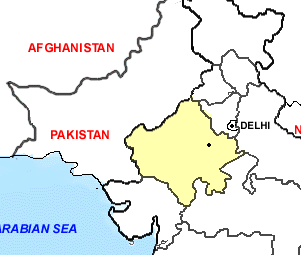
Abb.: Lage von Rajasthan, Indien
|
|
|
|
|
|
Vgl. Historic Resort Hotels Group Rajasthan. -- URL: http://www.hrhindia.com/. -- Zugriff am 2001-02-23]
|
|
|
|
|
|
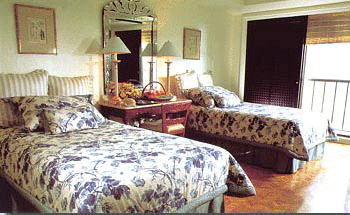 Abb.: "Manila Hotel", Manila, Philippinen |
|
|
|
|
"The Darjeeling Himalayan Railway is one of the most well known hill railways in the world...and a delight it is!! The Darjeeling Himalayan Railway (DHR) was built in 1881 and is over a hundred years old today. It connects the plains of West Bengal at New Jalpaiguri with the popular hill station of Darjeeling (6812 ft), a distance of about 50 miles. On the way it passes the most breathtaking scenery and climbs to a height of 7400 feet at Ghum (the highest station on IR & the 2nd highest station in the world), where on a clear day views of Mt. Kanchenchunga can be had.
The DHR has been served by little 'B' class 0-4-0 ST's (Saddle Tanks) throughout its existence. Other locos that have worked the line here are the 'A' class and a Garrat loco as well. The B class, which are probably one of the oldest working steam locos in the world, were built by the North British Locomotive Company (NBLC, Glasgow), Sharp Stewart, Baldwin and a few at the DHR works at Tindharia itself.
The DHR secured »World Heritage Status« in 1999.
This 2'ft gauge narrow gauge concern is a must for all railway enthusiasts!"[Bild- und Textquelle: http://members.tripod.com/~railinindia/dhr.html. -- Zugriff am 2000-07-17
Vgl: Rail in India : a collection of photographs. -- URL: http://members.tripod.com/~railinindia/. -- Zugriff am 2001-02-23]
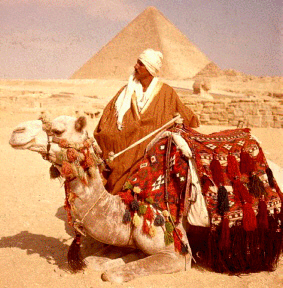
Abb.: Kameltreiber vor Großer Pyramide und Sphinx, Gizeh, Ägypten, 1961 (©
CORBIS)
"Cultural tourism has been popular for many years in Africa. Egypt, which boasts some of the continent's most ancient and spectacular monuments and artifacts, has for decades received a steady stream of tourists, most of whom come to see the Valley of the Kings, Thebes, the Nile, and the museums in Cairo.
Abb.: Lage von Marrakesch, Casablanca und Fes, Marokko (Quelle: CIA)
Abb.: Casablanca: The tall minaret of the Great Mosque Hassan II rises above the flat-roofed buildings of Casablanca, situated on the Atlantic coast of Morocco. (© CORBIS)
Abb.: Marrakesch, Marokko, aus der Vogelschau, ca. 1993 (©CORBIS)
Abb.: Fes, Marokko: Fez al Bali Seen Through the Bab Bou Jeloud, 1995 (© CORBIS)Together with cities such as Casablanca, Marrakech, and Fes, Egypt has helped make North Africa the continent's most visited region. For European tourists, North Africa's proximity makes it a viable destination even for short trips.
Abb.: Lage von Senegal, Gambia, Ghana, Benin (Quelle. CIA)Since the late 1970s cultural tourism has expanded to encompass a broader range of activities. West African countries, for example, are now attracting African Americans and other tourists interested in learning more about the Transatlantic slave trade.
Abb.: Stairways of Goree Island Slave House, near Dakar, Senegal (© CORBIS )Such tourists typically visit Goree Island, a major slave port off the coast of Senegal, as well as sites in Benin and Ghana. Three former slave forts in Ghana were declared World Heritage sites by the United Nations:
- Cape Coast Castle,
- Elmina Castle, and
- Fort Saint Jago.
"In dem Dorf Juffure, vier Tagereisen Stromaufwärts an der Küste von Gambia in Westafrika, wurde im Frühjahr 1750 dem Omaro Kinte und seiner Frau Binta ein Knabe geboren." [Beginn von: Haley, Alex <1921 - 1992>: Wurzeln : Roots. -- Frankfurt a. M. : Fischer, 1999. -- (Fischer Taschenbuch). -- ISBN 3596224489. -- Originaltitel: Roots (©1976). ]
In The Gambia, the village of Jufurre became a pilgrimage site for many African Americans after the television series based on Alex Haley's 1977 book Roots made it famous. Now the Gambia holds an annual Roots Homecoming Festival, which highlights the cultural ties between diasporic Africans and Africa. In addition to historic sites related to the slave trade. visitors can attend demonstrations of dance and wrestling, purchase traditional African crafts, and arrange to stay with local families.
Abb.: Lesedi Cultural VillageCultural tourism is also a growing business in southern Africa. Visitors to South Africa, for example, can spend a night in the home of a Xhosa, Sotho, Pedi, or Zulu family in the Lesedi Cultural Village outside Johannesburg. Residents of the village wear the traditional dress of their own people -- cotton wraps for the Xhosa, fur loincloths for the Zulu -- and perform dances and storytelling for the visitors.
[Webpräsenz: http://users.iafrica.com/d/da/dasart/lesedi/. -- Zugriff am 2001-02-23]
In Zimbabwe members of the Shangaan ethnic group began construction an a similar model village, where small numbers of visitors will be able to stay overnight and participate in village activities. Its organizers estimated that the venture had the capacity to generate $1 million annually, helping such social services as schools and hospitals for Shangaan communities. Proponents of this kind of cultural tourism maintain that it helps keep traditional cultural practices alive. Critics insist that tourists witness nothing more than 'staged authenticity' in model villages, and in the process intrude on the privacy of village residents."
[Fay, Robert: Tourism in Africa. -- In: Africana : the encyclopedia of the African and African American experience / editors: Kwame Anthony Appiah ... -- New York, NY : Basic Civitas, ©1999. -- ISBN 0465000711. -- S. 1858. ]
Webpräsenz: http://www.infojep.com/culturaltours/. -- Zugriff am 2001-02-23
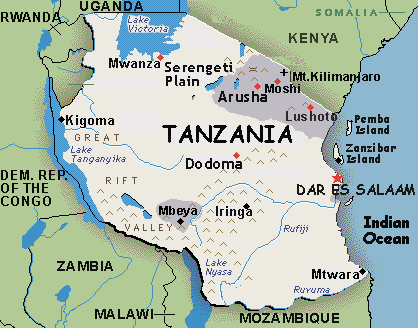
Abb.: Lage der Cultural Tourism Gebiete in Tansania
"Ng=iresi Cultural Tourism Programme Welcome to the fascinating slopes of Mount Meru, where you can experience real African village life.
We villagers of Ng'iresi offer you:
a guided tour to some farms on the green and steep slopes of Mt. Meru
a visit to several development projects in our village (soil conservation, irrigation, cross breeding, bio gas, fish nursery)
a climb to Kivesi Hill, an old volcano with a natural forest on top
a view into the Wa-arusha culture (old stories, traditional houses)
delicious lunch and dinner prepared by the Juhudi women's group (for smaller groups, meals are provided by a local family)
The profit will be used to improve our primary school
Thanks to your visit our children get better education.
A cultural tourism programme executed with advice from SNV B the Netherlands Development Organisation and the Tanzanian Tourist Board.
Introduction
Ng'iresi is situated 7 kilometres out of Arusha on the green and steep slopes of Mount Meru. The inhabitants of the village are all farmers of the Wa-arusha tribe. The Wa-arusha are family of the Maasai, but have gradually shifted from pastoralism to agriculture. Some Wa-arusha are still living in the traditional bomas, others try hard to build up stone houses; some still depend on their cows, others have cultivated large plots. The village perfectly shows the transition from traditional into modern African life.
On the steep slopes agriculture is not an easy activity. If farmers don't take preventive measures, soil erosion takes place rapidly. Many farmers now have started to place contour lines and build terraces. The irrigation system in the village further helps the farmers to increase their harvest. Some villagers even participate in other innovative projects, like a fish nursery, a biogas system and a cross breeding project.
All the activities take place on the magnificent slopes of Mount Meru, where small rivers race downhill cascading into impressive waterfalls. The volcanic activities of Mount Meru have created many small hills around Ng'iresi. Some of them easily can be climbed within an hour. From the top you have a beautiful view over the surrounding area.
Different modules
You can choose different modules that vary from half a day to one and a half day. Visitors are also welcomed to stay overnight or make their own custom tours incorporating different options.
Half day Tour
In the half day visit you will be welcomed with coffee and tea at Mzee Loti's farm and get an explanation about the biogas, crossbreeding and soil conservation projects on the farm. Next, you make a walk to some nearby bomas, where you can see the various styles of traditional Maasai and Wa-arusha houses. From there you start climbing Lekimana hill, from where you have a beautiful view over Arusha town and the surrounding Maasai plains. With clear weather Kilimanjaro is visible. You descend Lekimana hill on the other side, so that you can visit Ng'iresi primary school. Back at Mzee Loti's farm, you get a traditional meal cooked by the Juhudi women's group.
Day Long Tour
The one day tour adds a visit to the catchment forest on the higher slopes of Meru. Here you can see the spring that is the main water source for the village. A few meters downstream the farmers are building an intake for the irrigation system. Groups with a special interest can plan a visit to a traditional healer at the edge of the forest. Further downhill a fish nursery is visited in the backyard of a farmer. The day is finished with a dinner at Mzee Loti's farm.
Day and a Half Tour
During the one and a half day tour, you spend the night camping at Mzee Loti's farm. From here the next morning you start climbing of Kivesi hill, an old volcano with a natural forest on top. Baboons and gazelles can be seen in the forest. You descend the hill on the other side and return to Arusha.
On request other modules can be arranged as well.
Traditional Medicine Tour
All tours to Ng=iresi can include a visit to a traditional healer who is living in the area. However, visitors who are keen to learn more about the traditional medicine can spend a half or full day walking through the slopes of Mount Meru collecting herbs and plants that have been used by local people for 1000>s of years. A sheet listing the various plants will be given with their Latin and common name in the local dialect. A special guide will help you identify and collect samples of the numerous medicinal species.
Guides
Our guides are all villagers who have lived many years in Ng'iresi. They speak good English and can tell interesting stories about history, culture and daily life in our village. They also are well informed about the different development project in Ng'iresi and can tell you all the ins and outs about the Wa-arusha culture.
Meals
Meals are prepared by the Juhudi women's group. The women can make various traditional African meals, but can serve western food as well. All meals will be prepared in a clean environment. The women's group has already cooked for the Ambassadors of Sweden and The Netherlands.
Facilities
At Mzee Loti's farm there is a simple but clean toilet, from the model pit latrine. From the first revenue a small bathroom will be built that can be used by the guests who spend the night at the farm. Visitors can put up their tents on one of the shambaas around Mzee Loti's house. A watchmen will guarantee the safety. An idyllic dining place has been built under the green leaves of a jasmin tree. With rain, visitors can shelter in Mzee Loti's house.
Conservation of the natural forest
We see the natural forest on top of Kivesi hill as an important natural resource for our village. It helps us preventing further soil erosion, forms an important refuge for the many birds in our village, is used for initiation ceremonies in the Wa-arusha culture and is also a nice attraction for tourists. We want to preserve this natural forest and therefore don't cut any trees in the natural forest.
Improving Ng'iresi primary school
Ng'iresi primary school was built in 1975. The schoolbuilding consists of seven classrooms. In total 510 children attend the school. The classrooms are rather crowded and there are not enough learning materials for everyone. With the tourism programme we hope to generate funds that we can use for improving our primary school. From the money earned from the visit of every tourist, 4 US$ will go to a school development fund, used for improvements of the school. For one dollar we can buy two schoolbooks; five dollars is enough for wood from which the children can make a desk and for ten dollars we can buy a large topographic map of our country.
We hope that the tourism programme may help us to give better education to our children, so that they can acquire the knowledge and experience needed to lead a good and happy life. When you are in the village feel free to visit our primary school. Our children will welcome you with nice Swahili songs.
Tourist information
In Mto wa Mbu, tours can be arranged through the Tanzanian Tourist Board or your local tour operator.
The following costs in Tanzanian Shillings are as follows. Tour costs are subject to change. Please note that tours booked through tour operators may require an additional co-ordination fee.
Development Fee (per person for all tours): 2,500
Guide Fee (per person): 3,000
Lunch or dinner (optional): 3,500
Tea or Coffee: 300
Visit to Wa-Arusha Boma (per group): 4,000
Visit to Traditional Healer (per person): 1,000
Overnight Camping fee (optional): 1,000
For further information
Please contact your tour operator or TTB information Centre in Arusha (Boma Road, Tel: 057 - 3842/3)"
[Quelle: Ng=iresi cultural tourism programme. -- URL: http://www.infojep.com/culturaltours/ngiresi brochure.html. -- Zugriff am 2000-07-11]